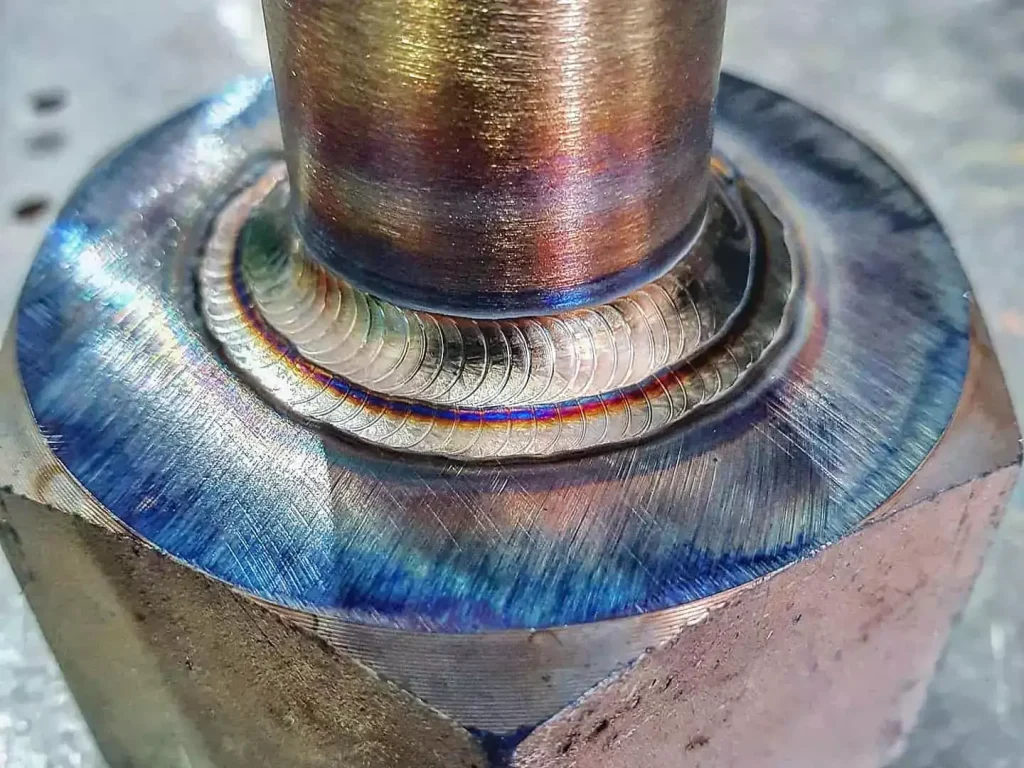Welding ductile iron to mild steel is entirely feasible when using nickel-based filler metals—such as ENiFe-CI (Nickel 55)—and following strict metallurgical controls to prevent cracking. Key steps include thorough surface cleaning, preheating to 350–650 °F (175–345 °C), controlled interpass temperatures, and slow post-weld cooling to relieve residual stresses. Common processes—SMAW, GMAW, and GTAW—can all achieve sound joints if paired with proper procedures and post-weld heat treatment, though resulting welds may exhibit lower toughness than base metals. Understanding these factors ensures reliable, crack-free welds when joining ductile iron components to mild steel structures.

1. Introduction
Ductile iron, also known as nodular or spheroidal graphite iron, contains graphite in nodule form, granting it superior toughness compared to grey cast iron.
Mild steel (e.g., ASTM A36) is a low-carbon steel with excellent weldability but different thermal expansion and microstructural behavior from ductile iron.
When joining these dissimilar metals, one must accommodate carbon migration, shrinkage, and stress concentration at the weld interface.
2. Metallurgical Considerations
2.1 Carbon Content & Dilution
Ductile iron’s carbon content (3.0–3.7 %) and silicon (1.2–2.8 %) promote carbide formation, while mild steel’s low carbon (< 0.3 %) yields a ferrite-pearlite matrix.
High nickel filler metal dilutes carbon migrating from the iron, preventing brittle martensite in the weld and heat-affected zone (HAZ).
2.2 Thermal Stress & Expansion
Differential thermal expansion (ductile iron ≈ 11–12 µε/°C vs. steel ≈ 12 µε/°C) can induce tensile stresses during cooling, risking cold cracking.
Slow cooling and post-weld heat treatment reduce residual stresses and hardness peaks in the HAZ.
3. Welding Processes & Filler Metals
| Process | Filler Metal | Advantages | Applications |
|---|---|---|---|
| SMAW | ENiFe-CI (FM Ni-55), ENi-Cl | All-position, good dilution control | Field repairs, heavy sections |
| GMAW | Ni-based wires (ERNiFe-CI) | High deposition rate, stable arc | Production welding |
| GTAW | Solid Ni rods (Alloy 800/800HT) | Precise heat input, low dilution | Thin sections, precision joints |
Note: ENiFe-CI electrodes are specifically designed for cast iron to steel joints, offering tensile strength up to ~84 ksi and elongation ~9 %.
4. Preheat, Interpass & Post-Weld Heat Treatment
-
Preheat:
-
350 °F (175 °C) minimum to open pores and reduce cooling rate.
-
Up to 650 °F (345 °C) in severe conditions to prevent cold cracking.
-
-
Interpass Temperature:
-
Maintain ≥ 300 °F (150 °C); ideally ~600 °F (320 °C) to limit thermal gradients.
-
-
Post-Weld Heat Treatment (PWHT):
-
Reheat to preheat temperature and cool slowly (12–24 h), often under a blanket, to relieve stresses.
-
5. Welding Procedure
-
Surface Preparation:
Remove paint, rust, and contaminants with grinding or stainless-steel wire brushing to ensure proper fusion. -
Tack Welding & Peening:
Use small tack welds to align parts; peen weld beads to redistribute stresses and encourage ductile microstructures. -
Controlled Welding:
-
Use short arc lengths (GMAW) or tight stick-out (SMAW) for low heat input.
-
Alternate sides or ends to balance heat and minimize distortion.
-
-
Slow Cooling:
-
Wrap in a welding blanket or controlled oven.
-
Allow cooling at < 100 °F/h to ambient to avoid thermal shock.
-
6. Applications & Limitations
-
Ideal Uses: Repairing pump casings, valve bodies, flanges, and component builds where mechanical joining isn’t viable.
-
Limitations: Weld metal toughness (~84 ksi) may not match high-strength ductile iron grades (> 100 ksi); consider mechanical fastening for critical load paths.
7. FAQ
Q1: Can ductile iron be welded to mild steel?
Yes—with nickel-based filler metals (e.g., ENiFe-CI) and proper pre/post-weld procedures to avoid cracks.
Q2: What preheat temperature is required?
Typically 350–650 °F (175–345 °C) depending on casting mass and ambient conditions.
Q3: Which welding process is best?
SMAW with ENiFe-CI offers field versatility; GMAW and GTAW provide higher control for precision work.
Q4: Is post-weld heat treatment mandatory?
Strongly recommended—reheat to preheat temperature and cool slowly over 12–24 h to reduce residual stresses.
Q5: Are there alternatives to welding?
Mechanical methods (bolting, press-fitting, adhesives) avoid thermal cracking risks and may be preferable for critical joints.
References:
- American Welding Society (AWS) – Authority on Welding Standards and Procedures
- ASME Codes and Standards – Metallurgical Controls and Welding Procedures
- ASTM A234 – Standard Specification for Piping Fittings of Wrought Carbon Steel and Alloy Steel for Moderate and High Temperature Service
- University of Cambridge – Welding of Dissimilar Metals and Metallurgical Considerations
- Ductile Iron – Wikipedia (Welding and Joining Methods Overview)

